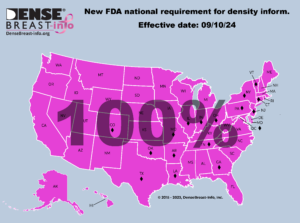

Beginning September 10, 2024, mammography facilities must provide all patients receiving a mammogram with one of two Federal breast density notification statements (either “not dense” or “dense”). Additionally, the mammogram report sent to referring providers must include an assessment of the patient’s breast density. See below for details on both.
Note: Mammography facilities should be aware of and comply with all applicable Federal and State (39 states and DC) “dense breast” reporting requirements. For instance, an individual state “inform” law may still remain in effect unless the state law is in conflict with the FDA required statement or specifically defaults to the new FDA standard, expires or is repealed.
The FDA has created a Compliance Guide with commonly asked Q+As, or they can be contacted here.
Learn more about implementing the national dense breast report standard and expanding supplemental screening using current guidelines here.
Patient Notifications
If NOT DENSE: “Breast tissue can be either dense or not dense. Dense tissue makes it harder to find breast cancer on a mammogram and also raises the risk of developing breast cancer. Your breast tissue is not dense. Talk to your healthcare provider about breast density, risks for breast cancer, and your individual situation.”
If DENSE: “Breast tissue can be either dense or not dense. Dense tissue makes it harder to find breast cancer on a mammogram and also raises the risk of developing breast cancer. Your breast tissue is dense. In some people with dense tissue, other imaging tests in addition to a mammogram may help find cancers. Talk to your healthcare provider about breast density, risks for breast cancer, and your individual situation.”
Report to Referring Providers
Written report must include assessment of breast density, classified as one of the following:
-
-
-
-
- “The breasts are almost entirely fatty.”
- “There are scattered areas of fibroglandular density.”
- “The breasts are heterogeneously dense, which may obscure small masses.”
- “The breasts are extremely dense, which lowers the sensitivity of mammography.”
-
-
-